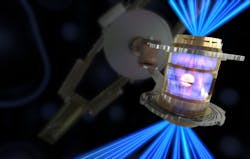National Ignition Facility achieves fusion ignition
On December 5, 2022, an experiment at NIF surpassed the fusion threshold by delivering 2.05 megajoules (MJ) of energy to the target—producing 3.15 MJ of fusion energy output. More energy was produced than used to drive it, which holds promise for clean power and nuclear weapons stewardship.
Fusion is the process of combining two light nuclei to form a single heavier nucleus, which releases a large amount of energy. Harking back to the 1960s, scientists hypothesized lasers could induce fusion.
This inertial confinement fusion effort was spearheaded by physicist John Nuckolls, LLNL director from 1988 to 1994, and sparked more than 60 years of R&D in lasers, optics, diagnostics, target fabrication, computer modeling and simulation, and experimental design.
LLNL spent years building increasingly more powerful laser beams, which led to NIF, the world’s most energetic laser system. NIF is located in Livermore, CA, and is the size of a sports stadium. Its powerful laser beams create temperatures and pressure like those within the cores of stars and giant planets, and inside exploding nuclear weapons.
“The pursuit of fusion ignition in the laboratory is one of the most significant scientific challenges ever tackled by humanity, and achieving it is a triumph of science, engineering, and most of all, people,” says LLNL Director Kim Budil. “Crossing this threshold is the vision that has driven 60 years of dedicated pursuit—a continual process of learning, building, expanding knowledge and capability, and then finding ways to overcome the new challenges that emerged. These are the problems that the U.S. national laboratories were created to solve.”
This achievement was made possible by LLNL employees, countless collaborators at DOE’s Los Alamos National Laboratory, Sandia National Laboratories and Nevada National Security Site, General Atomics, the University of Rochester’s Laboratory for Laser Energetics, MIT, UC-Berkeley, Princeton University, and international partners including the U.K.’s Atomic Weapons Establishment and the French Alternative Energies and Atomic Energy Commission.
